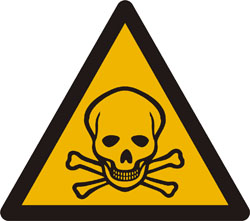Dangerous toxins in Chinese drywall force people from their homes.
Dangerous Drywall
Thousands of new homeowners nationwide are discovering that their homes were made with toxic drywall from China. These toxins are so dangerous that many people are being forced to leave their homes. The toxic Chinese drywall contains hydrogen sulfide and formaldehyde, which are making some homeowners sick with nosebleeds, sinus infections, and respiratory problems.
Shortage of Local Building Materials Led to Imports
After hurricanes Katrina and Wilma, and following a construction boom, the U.S. was experiencing a shortage of building materials. Inexpensive drywall was imported from China. Estimates find that more than 500 million pounds of Chinese gypsum board was imported from 2004 to 2008, enough to build tens of thousands of homes. The toxic drywall primarily ended up in the Southeast, with concentrations in Florida, Louisiana, and Mississippi.
Homeowners Hung Out to Dry
For the people who lived through hurricane Katrina, who may not have had insurance policies to cover the damage from the storm and subsequent flood, who are finally getting their homes rebuilt, who are now discovering that their new walls are dangerously toxic, their nightmare is still not over. Obviously these homeowners can't sell their home because no one wants to buy a toxic house. Worse still, in many cases, insurance companies are declining to fill their claims to have the toxic drywall removed, and then canceling their policies, declaring, "We provide insurance, not warranty service."
Is Your Drywall Toxic?
There are some telltale signs of toxic drywall. Often there is a rotten-egg odor caused by sulfur gases. If you can see the back of your drywall, look for printing that says Made in China or stamped with KNAUF. If the evaporator coils and copper wires on indoor air conditioning units are black, or if the copper wires behind the covers of electrical outlets are black, you have toxic drywall.
Better Drywall
Studies suggest that drywall is the third biggest producer of greenhouse gases among building materials. An alternate drywall option, called EcoRock, is made from 85% industrial by-products, is recyclable, and uses 20 percent of the energy that traditional drywall requires.
Related Articles
- Asbestos
- Controlling Moisture In The Home
- EPA Asbestos Guide
- Dust
- Hidden Home Health Hazards
- Removing Mold, Mildew Or Musty Odors From Your Home
- Toxic Mold Environments: Moisture and My Home
 Print
Print Email
Email








